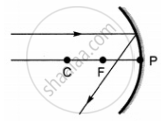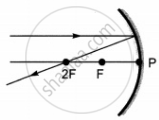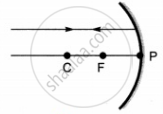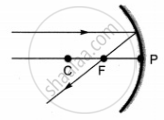Advertisements
Advertisements
Questions
Describe the positions of the source of light with respect to a concave mirror in Projector lamp.
Solution
In a projector lamp, the light source is at the centre of the curvature of a concave mirror, which produces an image of the shape of the object itself.
APPEARS IN
RELATED QUESTIONS
It is desired to obtain an erect image of an object, using concave mirror of focal length of 12 cm.
What should be the range of distance of an object placed in front of the mirror?
It is desired to obtain an erect image of an object, using concave mirror of focal length of 12 cm.
Where will the image of this object be, if it is placed 24 cm in front of the mirror? Draw ray diagram for this situation also justify your answer. Show the positions of pole, principal focus and the centre of curvature in the above ray diagrams
Draw ray diagrams to show the principal focus of a convex mirror.
List four specific characteristics of the images of the objects formed by convex mirrors.
The radius of curvature of a spherical mirror is 20 cm. What is its focal length?
The image formed by a concave mirror is observed to be virtual, erect and larger than the object. Where should be the position of the object?
Three students A, B and C focussed a distant building on a screen with the help of a concave mirror. To determine focal length of the concave mirror they measured the distances as given below:
Student A : From mirror to the screen
Student B : From building to the screen
Student C : From building to the mirror
Who measured the focal length correctly ;
(a) Only A
(b) Only B
(c) A and B
(d) B and C
Which type of mirror is used by a dentist?
Find the focal length of a concave mirror whose radius of curvature is 32 cm.
Fill in the following blank with suitable word:
The focal length of a concave mirror is the distance from the ......... to the mirror.
Fill in the following blank with suitable word:
A concave mirror .......... rays of light whereas convex mirror ............ rays
Draw diagram to represent the action of a concave mirror on a beam of parallel light rays. Mark on this diagram principal axis, focus F, centre of curvature C, pole P and focal length f, of the concave mirror.
For what position of an object, a concave mirror forms a real image equal in size to the object?
Explain why, a ray of light passing through the centre of curvature of a concave mirror gets reflected back along the same path.
With the help of a ray diagram, determine the position, nature and size of the image formed of an object placed at the centre of curvature of a concave mirror.
Described with the help of a diagram, the nature, size and position of the image formed when an object is placed beyond the centre of curvature of a concave mirror.
Draw ray-diagrams to show the formation of images when the object is places in front of a concave mirror (converging mirror):
(i) between its pole and focus
(ii) between its centre of curvature and focus
An object is placed at the following distances from a concave mirror of focal length 15 cm, turn by turn:
(a) 35 cm
(b) 30 cm
(c) 20 cm
(d) 10 cm
Which position of the object will produce:
(i) a magnified real image?
(ii) a magnified virtual image?
(iii) a diminished real image?
(iv) an image of same size as the object?
According to the "New Cartesian Singh Convention" for mirrors, what sign has been given to the focal length of:
a concave mirror?
One of the following does not apply to a concave mirror this is:
(a) focal length is negative
(b) image distance can be positive or negative
(c) image distance is always positive
(d) height of image can be positive or negative
An object 3 cm high is placed at a distance of 8 cm from a concave mirror which produces a virtual image 4.5 cm high:
(i) What is the focal length of the mirror?
(ii) What is the position of image?
(iii) Draw a ray-diagram to show the formation of image.
An object is placed just outside the principal focus of concave mirror. Draw a ray diagram to show how the image is formed, and describe its size, position and nature.
If the object is moved further away from the mirror, what changes are there in the position and size of the image?
An object is 24 cm away from a concave mirror and its image is 16 cm from the mirror. Find the focal length and radius of curvature of the mirror, and the magnification of the image.
What type of mirror should be used as a shaving mirror?
What would your image look like if you stood close to a large:
concave mirror?
Which of the following are concave mirrors and which convex mirrors?
Which of the following are concave mirrors and which convex mirrors?
Shaving mirrors, Car headlight mirror, Searchlight mirror, Driving mirror, Dentist's inspection mirror, Touch mirror, Staircase mirror in a double-decker bus, Make-up mirror, Solar furnace mirror, Satellite TV dish, Shop security mirror.
The mirror which can form a magnified image of an object is:
(a) convex mirror
(b) plane mirror
(c) concave mirror
(d) both convex and concave mirror
Draw a ray diagram to show the formation of the image of an object placed beyond the centre of curvature of a concave mirror. State the position, size and nature of the image.
Draw a ray diagram to show the formation of image of an object placed on the principal axis of a convex mirror. State the position, size and nature of the image. What happens to the image as the object is moved away from the mirror?
How can a concave mirror be used to obtain a virtual image of an object? Draw a diagram to illustrate your answer.
Suppose you have three concave mirrors A, B and C of focal lengths 10 cm, 15 cm and 20 cm. For each concave mirror you perform the experiment of image formation for three values of object distance of 10 cm, 20 cm and 30 cm. Giving reason answer the following:
(a) For the three object distances, identify the mirror/mirrors which will form an image of magnification – 1.
(b) Out of the three mirrors identify the mirror which would be preferred to be used for shaving purposes/makeup.
(c) For the mirror B draw ray diagram for image formation for object distances 10 cm and 20 cm.
A student has focused the image of a candle flame on a white screen using a concave mirror. The situation is as given below:
Length of the flame = 1.5 cm
Distance of flame from the mirror = 18 cm
If the flame is perpendicular to the principal axis of the mirror, then calculate the following:
- Distance of the image from the mirror
- Length of the image
If the distance between the mirror and the flame is reduced to 10 cm, then what would be observed on the screen? Draw ray diagram to justify your answer for this situation.
A student obtained a sharp image of the grills of a window on a screen using a concave mirror. His teacher remarked that for getting better results a well lit distant object (preferably the sun) should be focussed on the screen. What should be done for this purpose?
(A) Move the screen slightly away from the mirror
(B) Move the mirror slightly towards the screen
(C) Move the screen and the mirror away from the object
(D) Move the screen and the mirror towards the object
List four characteristics of the image formed by a concave mirror of focal length 40 cm when the object is placed in front of it at a distance of 20 cm from its pole.
Give any two applications of a concave and convex mirror.
Which of the following ray diagrams is correct for the ray of light incident on a concave mirror as shown in figure?

 |
 |
 |
 |
| A | B | C | D |
The mirror having reflection surface curved outward ______.
The mirror having reflecting surface curved inwards ______.
A concave mirror produces a magnification of +4. The object is placed ______.
For a real object, which of the following can produce a real image?
You are provided with a convex mirror, a concave mirror, a convex lens and a concave lens. You can get an inverted image from
An image formed by a lens is erect. Such an image could be formed by a
The ENT doctor uses a ______.
______ mirrors magnify the object placed close to them.
In torches, searchlights, and headlights of vehicles, the bulb is placed ______ of the concave mirror.
The image formed by a concave mirror is real, inverted and of the same size as that of the object, the position of the object should be ______.
Which type of mirror is used in the following?
Head lamps of a car
